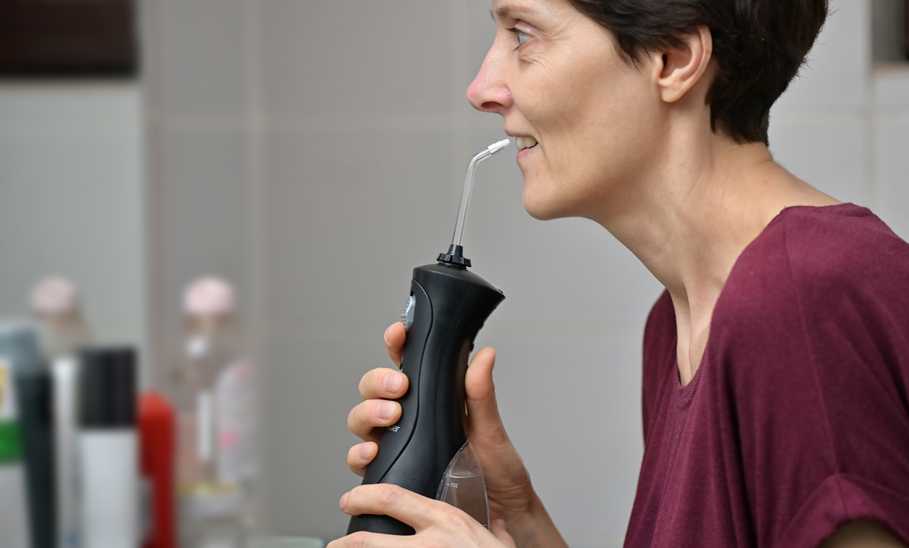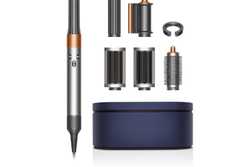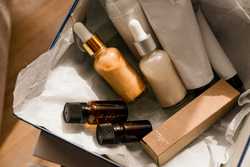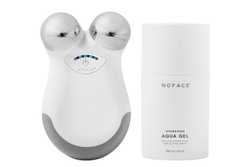The notion of water flossing is one that swirled around me for years—most loudly touted by my sister who is self-admittedly lazy with string flossing. But oral irrigators (as they are also known) weren’t a part of my family’s teeth-cleaning regimen until my 11-year-old got her braces.
After she was outfitted with her bright turquoise braces, we were sent home with a care packet and a recommendation from the dentist to get a water flosser to help her keep her teeth clean with all this new hardware in her mouth—and so our deep dive into water flossing began.
I have found amongst friends and family that people that love their water flossers really love them and are #TeamWaterFlosser all the way citing the way using oral irrigators leaves your mouth feeling just so darn clean. “It feels like I power washed my teeth!” raves my sister.
“Studies have shown that irrigating (or water flossing) helps improve gingivitis,” says Amber Lovatos, RDH, BSDH, a dental hygienist from Houston, Texas. She finds that in addition to people trying to combat gum disease (such as those who live with diabetes or other immunocompromising conditions that make them more susceptible to gum disease), water flossers can also be helpful for those with dexterity issues, braces, dental implants, and what she calls “poor flossing compliance” (i.e. people who don’t love or forget to string floss).
“I generally recommend oral irrigators as an adjunct to flossing and interdental brushes and not as a replacement for the mechanical removal of plaque,” Lovatos adds.
“Keeping your mouth clean has a direct link to your overall health,” reminds Dr. Ruchi Sahota, DDS, and consumer advisor for the ADA. In addition to brushing twice a day, she recommends flossing between teeth once a day, eating a nutritious diet, using fluoridated toothpaste, drinking water, and seeing your dentist regularly.
“Of course, you can use other interdental tools to keep your mouth clean,” she adds, “but whatever you use, always check in with your dentist regularly to make sure you are using them safely and effectively.”
Our top picks for the best water flosser
![[object Object] [object Object]](https://images.philips.com/is/image/philipsconsumer/771ffff6b7484834908aadb900f1a444?wid=420&hei=360&$jpglarge$)
Philips Sonicare Cordless Power Flosser 3000
My sister upgraded to this power flosser and she’s a fan of the long charge time (14-day charge capability) and the variety of pressure settings and tips. This Philips Power Flosser comes with two cleaning modes (Clean and Deep Clean), three intensity settings, and comes with a 360-degree rotating nozzle that can help you reach all the areas in your mouth. “This is my favorite tool for getting a thorough yet gentle clean in-between teeth,” says Dr. Veytsman.
We also love the two year limited warranty, that it comes in three cool colors (including mint).
Specifications
- Type: Cordless
- Tips included: Yes
- Water capacity: 250 ml
- Pressure settings: Two flossing modes and three intensities
- Charge type: USB-A and small plug cable
- ADA Seal of Acceptance: No
- Warranty: Two-year limited
- Price on publish: $79.96
Pros:
- Color variety (black, mint, and white)
- Long charge time
- The quadrant mode that flows water in four directions to loosen food and plaque
The bottom line:
A powerful portable flosser that tops best-of lists.
![[object Object] [object Object]](https://cdn11.bigcommerce.com/s-2idmiil7bp/images/stencil/1280x1280/products/783/3484/OctoberSale_PDPs_WaterFlosser_D__99387.1633018677__47489.1662438519.png?c=1)
Oral B Water Flosser Advanced
“This water flosser is great for those with sensitive teeth,” says Lovatos, “because you can choose the power setting.” The Oral B has three settings: Intense, Medium, and Sensitive and boasts “Oxyjet Technology,” which enriches water with “microbubbles of air” that help eliminate plaque bacteria. It also comes with three-stream settings: multi-jet for all-around cleaning, focused for targeted cleaning, and rotational for gum massage.
Specifications
- Type: Cordless
- Tips included: Yes
- Water capacity: 150 ml
- Pressure settings: Three
- Charge type: Rechargeable battery and charging station
- ADA Seal of Acceptance: No
- Warranty: Two-year limited
- Price on publish: $89.99
Pros:
- Customizable settings
- Cordless with convenient charging station
Cons:
- Doesn’t have the ADA Seal of Acceptance
The bottom line:
A hard-working handheld device for those with sensitive teeth.
![[object Object] [object Object]](https://i5.walmartimages.com/asr/91500a55-22f9-4cc4-8ae1-ff534f2d03b0.901f254b9d8e1e7a666f325a2369488a.jpeg?odnHeight=450&odnWidth=450&odnBg=ffffff)
Waterpik Sonic-Fusion 2.0 Professional Flossing Toothbrush
With over 12,000 five-star Amazon ratings, reviewers love the all-in-one cleaning station and boast their dentists rave about their oral hygiene. Waterpik was the first water flosser brand to earn the ADA Seal of Acceptance and this device comes with two brush heads that also have water flossing capabilities. It has two speeds (high & low) and you can switch from brush to floss with the touch of a button.
Specifications
- Type: Countertop device
- Tips included: Yes
- Water capacity: 150 ml
- Pressure settings: Three
- Charge type: Rechargeable battery and charging station
- ADA Seal of Acceptance: Yes
- Warranty: Three-year limited
- Price on publish: $166.29
Pros:
- All in one capability
- ADA seal of acceptance
Cons:
- Can’t travel with this
- Only two intensity settings
The bottom line:
A good investment for all-in-one power teeth cleaning.
![[object Object] [object Object]](https://i5.walmartimages.com/asr/e6d0bff6-cde1-4e66-a589-0ec3df4a5ef0.65474bdcfabdd669d724c7b6290c3890.jpeg?odnHeight=450&odnWidth=450&odnBg=ffffff)
Waterpik Cordless Express Portable Water Flosser
5% offSave $2
This easy to use and easy to clean cordless water flosser is affordable, battery charged, and you can use it in the shower. It features two pressure settings and a removable reservoir you can wash in the dishwasher. A perfect device for those new to water flossing and an accessible design ideal for kids or those with dexterity issues.
Specifications
- Type: Cordless
- Tips included: Yes
- Water capacity: 150 ml
- Pressure settings: Two
- Charge type: Battery operated (3 AA’s)
- ADA Seal of Acceptance: Yes
- Warranty: One-year limited
- Price on publish: $37.97
Pros:
- Affordable price, great for beginners
- Comes in black and white
- ADA seal of acceptance
Cons:
- Have to change batteries every one to two months
The bottom line:
An ultra-affordable model from a well-known brand.
![[object Object] [object Object]](https://m.media-amazon.com/images/I/31LkxhKvbRL._SL500_.jpg)
Waterpik Cordless Slide Professional Water Flosser
11% offSave $10
This best-selling Waterpik comes in three colors: blue, gray, and white, and is a powerful device that travels easily for those on the go. It’s called a “slide” because it collapses to 50% of its size for easy storing and carrying. The rechargeable lithium-ion battery provides up to four weeks of use from a single charge, and it comes with four tips for various needs, including orthodontics and implants. Toss it into one of our recommended travel toiletry bags.
Specifications
- Type: Cordless
- Tips included: Yes
- Water capacity: 6 ounces
- Pressure settings: Three
- Charge type: Rechargeable lithium-ion battery
- ADA Seal of Acceptance: Yes
- Warranty: Two-year limited
- Price on publish: $70.41
Pros:
- Space saving
- Comes with four different tips
- Several color options
The bottom line:
A space saving, and powerful device that is ideal for traveling.
![[object Object] [object Object]](https://i5.walmartimages.com/asr/ef30ea0c-e82d-4271-b1cb-96628b8bfce9.af88dd2a97fdaff8504123a7b290c01d.jpeg?odnHeight=450&odnWidth=450&odnBg=ffffff)
Waterpik ION Professional Rechargeable Water Flosser
16% offSave $21
This small but mighty machine comes with seven tips, 10 pressure settings, and a rechargeable lithium battery that gives a one-month charge. For those wanting intense cleaning options, this compact countertop machine is on many best-of lists for its wide range of capabilities and ease of use and cleaning.
Specifications
- Type: Cordless
- Tips included: Yes
- Water capacity: 20 ounces
- Pressure settings: 10
- Charge type: Rechargeable lithium battery
- ADA Seal of Acceptance: Yes
- Warranty: Three-year limited
- Price on publish: $127
Pros:
- Maneuverable handle
- 10 settings
- Easy to clean (top-rack dishwasher safe)
Cons:
- Pricier side of Waterpik models
The bottom line:
A powerful machine that's easy to handle for those whose teeth need extra cleaning.
![[object Object] [object Object]](https://i5.walmartimages.com/seo/Waterpik-ADA-Accepted-WP-660-Aquarius-Water-Flosser-White_704984f4-aee6-497d-b5cc-1541a56121da.05bbcbaae2cd2a32743f10b17850f94c.jpeg?odnHeight=640&odnWidth=640&odnBg=FFFFFF)
Waterpik Aquarius ADA Approved
15% offSave $14
This highly recommended device comes with seven tips and 10 settings, including a “hydro-pulse massage” mode that is ideal for gum health and plaque removal. Also, comes with a small, maneuverable handle—ideal for kiddos and those with dexterity issues—which allows for extended reach to get to the back of your mouth. I also love that one machine can be used by multiple family members by simply changing the flosser tips.
Specifications
- Type: Countertop
- Tips included: Yes
- Water capacity: 22 ounces
- Pressure settings: 10
- Charge type: Plug in
- ADA Seal of Acceptance: Yes
- Warranty: Three-year limited
- Price on publish: $100.97
Pros:
- Quiet
- Easy to read LED panel
- Smaller than most countertop models
The bottom line:
This compact machine can be used by multiple family members.
![[object Object] [object Object]](https://m.media-amazon.com/images/I/51KErNeXA0L._SL500_.jpg)
G.CATAAC Portable Water Flosser
I bought this budget flosser for my 11-year-old when she got her braces. The dentist didn’t recommend a brand, and my husband found this one on Amazon based on capabilities and reviews. It’s a very child-friendly device that my daughter can handle and refill herself. We love that it comes with child settings plus four separate pics so her little sister can use it too. So far, it’s a great value.
Specifications
- Type: Cordless
- Tips included: Yes
- Water capacity: 10 ounces
- Pressure settings: Five
- Charge type: Rechargeable lithium battery
- ADA Seal of Acceptance: None
- Warranty: One year
- Price on publish: $29.99
Pros:
- Affordable
- Good grip for a tween
- Easy to use
The bottom line:
An affordable, useful tool that’s easy for tweens to handle and refill themselves.
![[object Object] [object Object]](https://i5.walmartimages.com/asr/f72a1bf8-0917-4965-b43c-d005597c2c8c.88704bad75eb38a24636a4ce77bd9c15.png?odnHeight=450&odnWidth=450&odnBg=ffffff)
Waterpik Nano Compact Water Flosser
This popular device is 50% smaller than most countertop flossers, and its price point is smaller too. The reservoir inverts for convenient transport and storage, and it comes with two tips and three settings. Reviewers like that it seems as powerful as older Waterpik models while taking up considerably less counter space.
Specifications
- Type: Countertop
- Tips included: Yes
- Water capacity: 15 ounces
- Pressure settings: Three
- Charge type: Plug in
- ADA Seal of Acceptance: Yes
- Warranty: Two-year limited
- Price on publish: $45.82
Cons:
- Two-year limited warranty versus three compared to some of the other Waterpik models
The bottom line:
A compact and affordable Waterpik model that still packs a punch.
![[object Object] [object Object]](https://i5.walmartimages.com/asr/5845adfc-f664-49b1-b13c-da9c7a86d945.8848f6dc05c43943ca248f6553a56279.jpeg?odnHeight=450&odnWidth=450&odnBg=ffffff)
Equate HydroClean Cordless Water Flosser
Recommended by a dental hygienist friend as an affordable option, this no-frills model comes with two tips that rotate 360 degrees for accessing hard-to-reach areas in the mouth. Battery operated and comes with an easy to clean reservoir and a quick release for easy tip change-out.
Specifications
- Type: Cordless
- Tips included: Yes
- Water capacity: 5 ounces
- Pressure settings: Two
- Charge type: Battery operated (2 AA’s)
- ADA Seal of Acceptance: No
- Warranty: None
- Price on publish: $19.47
Pros:
- Super affordable
- Portable
Cons:
- Only two pressure settings
The bottom line:
This no-frills device comes recommended by dental professionals and is an affordable option if you’re on a budget.
![[object Object] [object Object]](https://images.philips.com/is/image/philipsconsumer/be6d0386bf424d06b5afadba00915cb2?wid=420&hei=360&$jpglarge$)
Philips Sonicare Power Flosser 3000
I’m kind of in love with this tiny but high-tech device that features “pulse wave technology” which pauses the waterflow when it's time to move on to cleaning the next tooth, so you have a built-in guide and don’t miss any spots. Its “Clean” and “Deep Clean” flossing modes feature a “whisper quiet design” so you can floss silently if loved ones are already asleep.
Specifications
- Type: Countertop
- Tips included: Yes
- Water capacity: 550 ml
- Pressure settings: 10 intensities
- Charge type: Multi-voltage charger
- ADA Seal of Acceptance: No
- Warranty: Two-year limited
- Price on Publish: $89.96
Pros:
- “Whisper quiet” design so you can floss silently
- X-shaped water streams cover more surface area for a faster, deeper clean
- Small and inconspicuous
Cons:
- Not every reviewer likes the pause function
The bottom line:
This super-compact machine offers high tech cleaning in a conveniently small package.
Why use a water flosser?
“Floss is boss, but water is better,” says Dr. Marcantel. “It’s almost like light pressure washing for your teeth and gums, which increases blood flow to the gums and helps reduce inflammation. Everyone’s familiar with those therapeutic shower heads that massage; it’s the same concept,” she adds.
Usage tips and techniques
For those new to water flossers, Lovato recommends starting on the lowest pressure setting.
Other tips include:
- Don’t turn on the water until the flosser is in your mouth or it will spray everywhere.
- Don’t use cold (or hot) water, especially if you have sensitive teeth; lukewarm is ideal.
- Water floss over the sink or the shower and allow the water to flow out of your mouth (it can get messy).
- Aim the tip at the gum line starting from the back teeth and move forward.
- Water floss the front (cheek side) and back (tongue side) of your teeth.
- Pause between teeth to allow the water to flow in between the teeth.
Both my sister and Dr. Marcantel suggest adding Listerine to your water flossing routine for next-level cleaning. My sister adds it to her mouth while Dr. Marcantel adds some to her flosser reservoir. Lovatos suggests checking with the product manufacturer first but generally says, “Yes you can use a diluted amount (one to one) of mouth rinse and water. You will want to run water through your water flosser afterward.”
How we selected the best water flosser
I interviewed dentists, hygienists, experts from the American Dental Association, as well as polled friends, family, and colleagues for tips and advice. In addition, I tested multiple products, offered my own first-hand experience, and scoured customer reviews to find the best water flossers for you.
What to consider when buying a water flosser
How you will use it
“The best product is the product you will use.” says Lovatos. “So if you think you will be more compliant with water flossing in the shower, you'll need a waterproof one. If you are frequently traveling, you’ll want a compact one that can travel with you. If you prefer a device that has multiple tips and power modes, you likely would benefit from one that is a bit ‘heavy-duty’ that sits on your counter,” says Lovato. In short, look for something that fits you and your lifestyle.
Cordless vs countertop
Many water flossers are handheld and either powered by batteries or a charger. What are called “tank flossers” sit on your countertop, plug into an outlet offering more power in terms of intensity and setting options, and come with a larger reservoir from which your “wand” or flosser extends. “I prefer corded versus portable,” says Dr. Esmeralda Diaz Marcantel, a Florida-based DDS. “They have more power, and for me, the larger reservoir equals to more time flossing which hopefully equals to better results,” she says.
The drawback to the countertop versions is that they take up more visible space but offer more ease because you don't have to refill your flosser every time. Depending on your bathroom set up and what you need from your irrigator will help you decide which is best for you.
Settings level
“Look for a device that offers several intensity settings, so you can have the most comfortable flossing experience.” says Dr. Victoria Veytsman, DDS, who has practices in Los Angeles and New York City. “Remember your mouth is delicate,” adds Dr. Sahota, “so don’t put it to the highest settings or you might traumatize the red tissues in your mouth.”
ADA Seal of Acceptance
Sarhota recommends visiting the ADA website to check your product for the ADA Seal of Acceptance. To help consumers, and dental professionals, choose and recommend dental products that are safe and effective, the ADA Council on Scientific Affairs launched the first Seal of Acceptance in 1931. To be granted a Seal, a product must include data from clinical and/or laboratory studies that demonstrate safety and efficacy in accordance with requirements developed by the ADA. If a product meets the requirements, they are awarded the ADA Seal of Acceptance for five years.“You know you can trust these products,” says Dr. Sahota, “and know it will do what it says it will do.”
Budget
Water flossers can range in price from about $20 to around $150. As you’ll see below, you can find many well-rated, affordable options, but they might not all come with the ADA Seal of Acceptance or a warranty, so do your homework.
Frequently asked questions (FAQs)
Which dental water flosser is best?
”Normally, I’d dive into the pros and cons to each type and brand, but I’ll pause here and share my thoughts as a clinician: it doesn’t matter. I want everyone to do it so I won’t preclude any readers from water flossing with my bias! Just try one, give it an honest shot for one week and see whatcha think! I would say anything between $30 to $100 is a good option,” says Dr. Marcantel.
Do dentists recommend water flossers?
“As a dentist, I recommend water flossing but let me be clear: as an adjunct. You can’t beat the mechanical debridement of plaque with traditional floss. So while I’m a big fan of my water wand, it’s always after my traditional floss,” says Dr. Marcantel.
What is the difference between a Waterpik and a water flosser?
“Water flosser, power flosser, and oral irrigator are synonymous names for interdental cleaners, while Waterpik is a brand name,” says Cindy Sensabaugh, RDH, a registered dental hygienist.
Do water flossers really work?
“Yes,” says Dr. Veytsmann. “Power flossers are often more effective at removing bacteria than string floss because they can hyper-target even the smallest of crevices between the teeth and gum line for a more thorough clean.”
How do water flossers work?
“These products typically pull water from a reservoir and dispense it through a tip at a rapid rate to remove debris and bacteria between teeth and the gumline,” says Sensabaugh. “The plaque in your mouth has bacteria that causes inflammation: gum irritation, bleeding, and swelling. To reduce that inflammation, we need to remove that plaque. Water flossers help by removing plaque and thus reducing inflammation,” adds Lovato.


![[object Object] [object Object]](https://images.philips.com/is/image/philipsconsumer/771ffff6b7484834908aadb900f1a444?wid=420&hei=360&$jpglarge$)
![[object Object] [object Object]](https://cdn11.bigcommerce.com/s-2idmiil7bp/images/stencil/1280x1280/products/783/3484/OctoberSale_PDPs_WaterFlosser_D__99387.1633018677__47489.1662438519.png?c=1)
![[object Object] [object Object]](https://i5.walmartimages.com/asr/91500a55-22f9-4cc4-8ae1-ff534f2d03b0.901f254b9d8e1e7a666f325a2369488a.jpeg?odnHeight=450&odnWidth=450&odnBg=ffffff)
![[object Object] [object Object]](https://i5.walmartimages.com/asr/e6d0bff6-cde1-4e66-a589-0ec3df4a5ef0.65474bdcfabdd669d724c7b6290c3890.jpeg?odnHeight=450&odnWidth=450&odnBg=ffffff)
![[object Object] [object Object]](https://m.media-amazon.com/images/I/31LkxhKvbRL._SL500_.jpg)
![[object Object] [object Object]](https://i5.walmartimages.com/asr/ef30ea0c-e82d-4271-b1cb-96628b8bfce9.af88dd2a97fdaff8504123a7b290c01d.jpeg?odnHeight=450&odnWidth=450&odnBg=ffffff)
![[object Object] [object Object]](https://i5.walmartimages.com/seo/Waterpik-ADA-Accepted-WP-660-Aquarius-Water-Flosser-White_704984f4-aee6-497d-b5cc-1541a56121da.05bbcbaae2cd2a32743f10b17850f94c.jpeg?odnHeight=640&odnWidth=640&odnBg=FFFFFF)
![[object Object] [object Object]](https://m.media-amazon.com/images/I/51KErNeXA0L._SL500_.jpg)
![[object Object] [object Object]](https://i5.walmartimages.com/asr/f72a1bf8-0917-4965-b43c-d005597c2c8c.88704bad75eb38a24636a4ce77bd9c15.png?odnHeight=450&odnWidth=450&odnBg=ffffff)
![[object Object] [object Object]](https://i5.walmartimages.com/asr/5845adfc-f664-49b1-b13c-da9c7a86d945.8848f6dc05c43943ca248f6553a56279.jpeg?odnHeight=450&odnWidth=450&odnBg=ffffff)
![[object Object] [object Object]](https://images.philips.com/is/image/philipsconsumer/be6d0386bf424d06b5afadba00915cb2?wid=420&hei=360&$jpglarge$)



